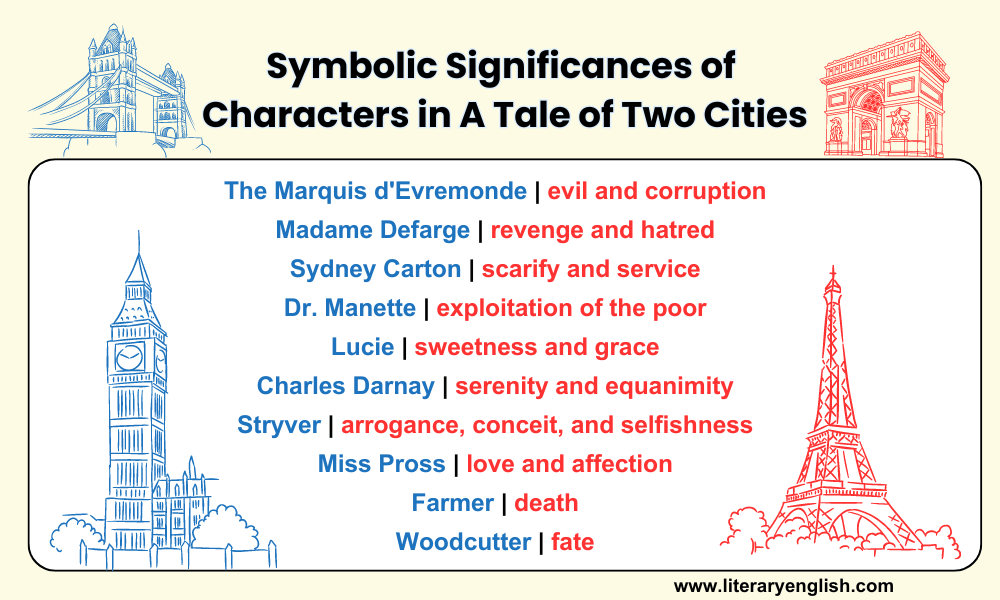Symbolic Significances of Characters in A Tale of Two Cities
Many of the characters in A Tale of Two Cities have a symbolical significance. Charles Dickens has a perfect control over art of characterization and he use them perfectly to achieve his ends. All the characters are either an allegory or a symbol. In this short lesson, there is a brief symbolic significance of characters in A Tale of Two Cities.
The Marquis d’Evremonde | evil and corruption
Symbolic significance of d’Evremonde reflects French Revolution on factual grounds. Marquis d’Evremonde is the symbol of inhumanity stonehearted aristocracy and callousness of the privileged class. He is a symbol for evil and corruption and represents the ruling class of aristocrats. He can do anything to meet his objectives and he is completely ignorant to the lives of the peasants whom he exploits. He lacks sympathy for the poor people as his attitude and behavior exposes him when he tramples a child to death under his carriage.
Multiple events expose him and at the same time upper class of France, that how they behave to lower-class people. The rape of a young woman, murder of her brother, Doctor Manette’s imprisonment for eighteen years, and their hold on government authorities reveals stonehearted aristocracy of upper class in France at that time.
Madame Defarge | revenge and hatred
Madame Defarge symbolizes revenge, hatred, evil, and violence. Her knitting throughout the story becomes a symbol of revolutionary ruthlessness. Her revengeful and blood-thirsty motive are certainly the outcome of cruelty of French aristocracy. Her knitting was a slow process that was molding bloody La Guillotine that engulfed thousand lives.
Sydney Carton | scarify and service
Sydney Carton is one of the main symbolic figures. He is the personification of self-sacrifice and service to humanity. His sacrificial death symbolizes a magnificent service to the humanity and true love among human beings.
Dr. Manette | exploitation of the poor
Dr. Manette symbolizes the exploitation of the poor class that how poor were crushed under the aristocracy’s hold. Such suppressions forced poor talented people to crush like a rotten paper and Dr. Manette is the example; who turned into a shoe-maker? Through his character, it reveals that how official French authorities were under control of aristocracy. Dr. Manette remains in prison for eighteen years without any crime because authorities put him to prison only to obey aristocracy.
Lucie | sweetness and grace
Lucie is the personification of for sweetness and grace. Her attachment with her father and her attitude toward Miss Prose is truly humble. She is a unifying force that bonds people.
Charles Darnay | serenity and equanimity
Charles Darnay symbolizes serenity and equanimity. In Darnay’s portrait, we see many shades of Charles Dickens. He is a balance personality who is encircled by many external factors and finally with the help of Sydney Carton, He becomes able to escape the cruelties of mankind under the label of French Revolution.
Stryver | arrogance, conceit, and selfishness
The character of Stryver symbolizes arrogance, conceit, and selfishness among mankind. He calls himself a lion, and Sydney Carton a `jackal’ but the jackal becomes the Christ-like figure and Stryver reflects himself only “stout fond bluff’. Stryver does not understand that his professional success is only due to assistance of `the jackal’ and he himself is nothing.
Miss Pross | love and affection
Miss Pross is a symbol of love and affection. Her deep and abiding attachment to Lucie reveals her affectionate personality. During the fight between Madame Defarge and Miss Pross, the death of Madame Defarge symbolically represents that truth prevails and evil is self-destructive.
Farmer | death
Farmer and woodcutter are also pure symbolic figures. The character of farmer symbolize death who is continuously sowing the seeds of death; death that would come in the wake of the French Revolution. The symbolic idea is that, the two forces woodcutter and farmer are silently doing their jobs to ruin human happiness in the form of Revolution. The planted trees by the farmer turned into wooden spear, the deadly weapon of revolutionaries.
Woodcutter | fate
The character of woodcutter is a symbol of fate: unchangeable destiny, at whose wish a man may live or die. He represents the coming destruction is inevitable that would overcome humanity. The revolutionaries weapons were wood spears, and the woodcutter molded these deadly weapons to cause bloodshed. As Dickens says about woodcutter and farmer; “They work silently, no one hears them as they go about with muffled steps”
Conclusion | bottom lines
You have gone through the symbolic significance of main characters of the novel. Some characters have more than one symbol due to change in their personality. As in the case of Sydney Carton, his role is different in the start, and at end, he is totally changed. He starts from zero and ends with the title of hero. Other characters are also presented symbolically up to some extant, but due to less presence on canvas, they have less significance.
